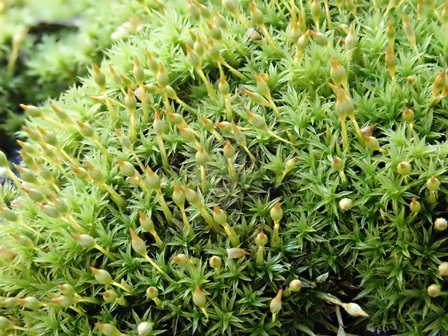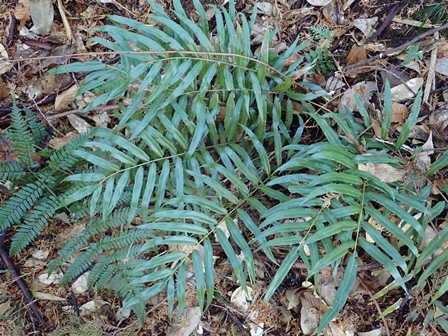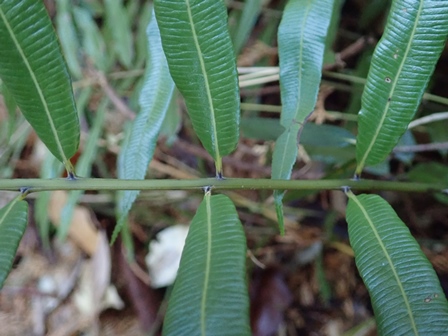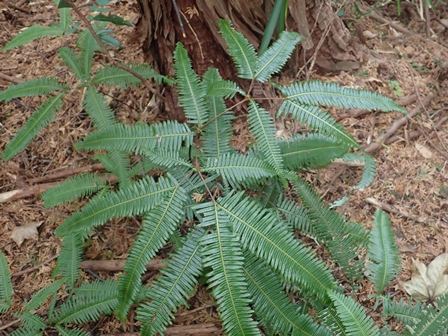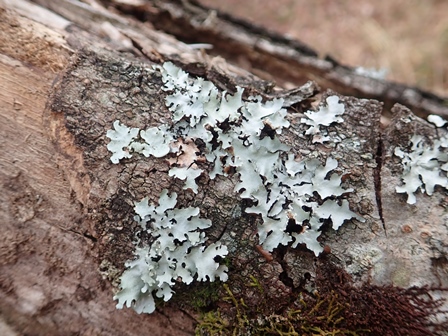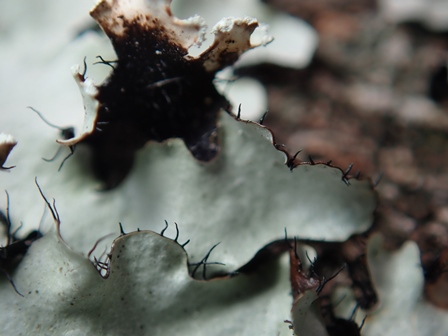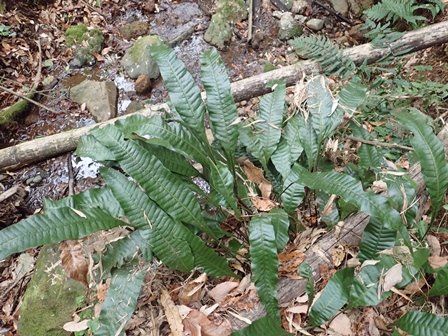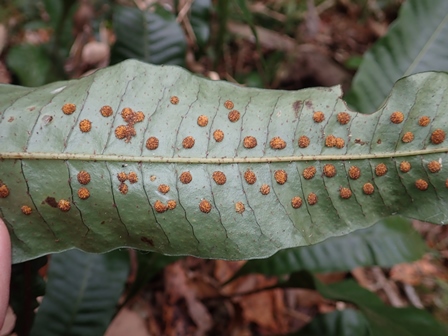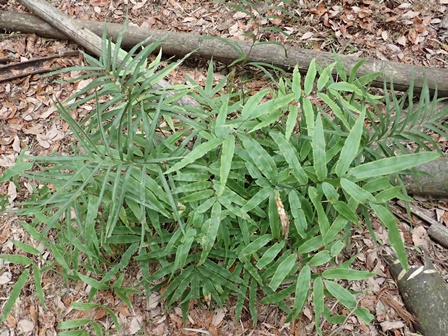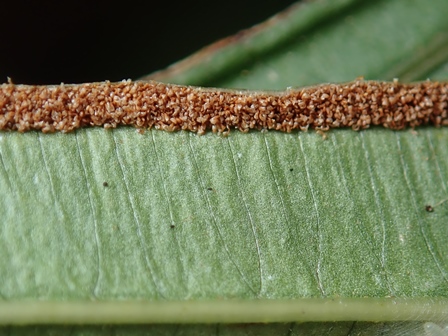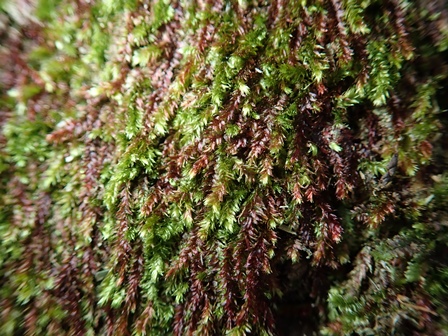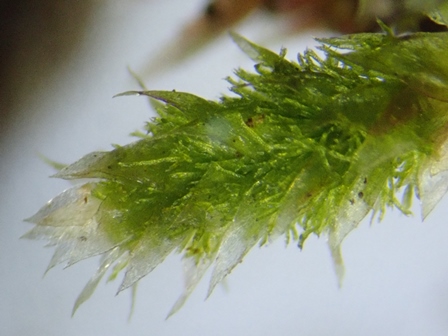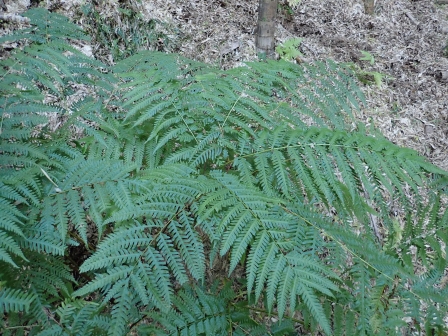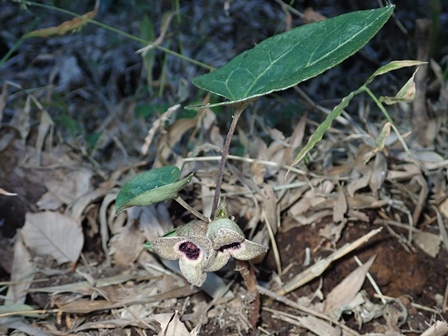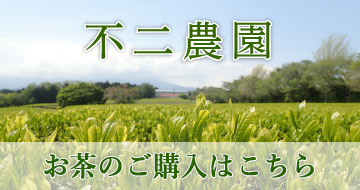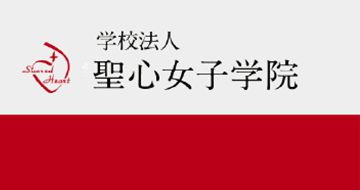フィールド日記
2021年01月
2021.01.29
サヤゴケ
共生の森の近くで、サヤゴケを見つけました。乾燥や大気汚染に強く、都市部でも見つけることができるコケです。和名は、朔(さく、胞子をつくる器官)の柄が葉に包まれていることに由来します。
I found a moss called "Saya-goke (サヤゴケ)" near the Kyoseinomori-Forest (共生の森). They are resistent to dryness and air pollution, so you can find them in urban areas. "Saya (サヤ)" in its name means "sheath" and comes from the fact that the stalks in their capsules, which produce spores, are wrapped by leaves.
2021.01.26
オオキジノオ
ヒノキ林の林床にオオキジノオが生えています。暖地の林内に生えるシダ植物で、北限に近い東京や神奈川では絶滅危惧種に指定されています。和名は葉の形がキジの尾羽に似ていることに由来するようです。
近縁種のキジノオシダによく似ていますが、羽片に柄があることで区別することができます。
I found a fern called "Oo-Kijinoo (オオキジノオ)" on the Japanese cypress woodland floor. They are a fern plant that grows in warm climate. They are designated as endangered species in the areas near the northern limit like Kanagawa and Tokyo. "Kijinoo (キジノオ)" in its name means "feathers pheasant's tail" and it comes from the shape of their leaves.
They are similar to their close relative species called "Kijinoo-Shida (キジノオシダ)", but you can identify them by the fact that the pinna of "Oo-Kijinoo (オオキジノオ)" has a stalk.
2021.01.22
コシダ
聖心坂の近くの森の中でコシダを見つけました。葉の軸の先端に芽があり、二叉に分枝を繰り返しながら成長するという特徴があります。硬く、つるつるした葉の軸は、編みかごの材料として使われていたようです。
I found a fern called "Koshida (コシダ)" in a forest near the "Seishin Zaka(聖心坂)". They have a shoot at the end of their leaf axis and grow dichotomous branches repeatedly. The leaf axes are smooth and tough, so people used them to make wicker baskets.
2021.01.19
マツゲゴケ
共生の森でマツゲゴケを見つけました。名前にコケとついていますが、コケ植物ではなく、菌類と藻類の共生体である地衣類の仲間です。日本の低地の代表的な種ですが、都市部ではあまり見られません。
和名は地衣体の縁に見られるシリアと呼ばれるマツゲ状の構造が由来です。
I found "Matsuge-goke (マツゲゴケ)" on a tree in the Kyoseinomori-Forest (共生の森). The name has the word "koke (コケ)", which means "moss", but they are not a moss plant. They are lichen, which is a symbiont that consist of fungi and algae. This species is common in Japan but you hardly see them in urban areas. "Matsuge (マツゲ)" in its name means "eyelash" and it comes from the eyelash-shaped features that they have on the edge of their body.
2021.01.15
クリハラン
裏道の小川のそばでクリハランを見つけました。名前の通り、クリの葉に似た葉をもつシダ植物です。
切れ込みのない葉はシダらしくありませんが、裏面には円形の胞子のう群がついており、シダ植物であることがわかります。
I found this fern called "Kuriharan (クリハラン)" by a stream on the back road. "Kuri (クリ)" in its name means "chestnuts". As the name suggests, their leaves resemble chestnuts' leaves. You may think the leaves without laciniae don't look like fern plants, but you will understand that the plant is fern by seeing the round-shaped sori on the back of the leaves.
2021.01.12
オオバノイノモトソウ
裏道でオオバノイノモトソウを見つけました。近縁種のイノモトソウに似ていますが、より大型です。葉は胞子をつける胞子葉と胞子をつけない栄養葉の2種類があり、胞子葉の羽片は栄養葉の羽片に比べ、幅が狭くなっています。
胞子のう群は、葉のふちに沿ってついています。
I found this fern called "Oobano-inomotosou (オオバノイノモトソウ)" on the back road. They are similar to their close relative species called "Inomotosou (イノモトソウ)", but are larger. They have two types of leaves. One is a fertile leaf, which has spores. The other is a sterile leaf, which doesn't have spores. Their fertile leaves are narrower than their sterile leaves. You can see their sori are along the edge of the leaves.
2021.01.08
アカイチイゴケ
湿った斜面にアカイチイゴケが見られます。季節によって赤みを帯びるというめずらしい特徴を持っています。特に冬にかけて赤みを帯びることが多いようです。
葉の付け根に糸状の無性芽をつけるという特徴もあります。
I found moss called "Akaichiigoke (アカイチイゴケ)" on a moist slope. They are unique in that their body turns reddish in winter.
They have another characteristic that they have thread-shaped asexual buds in the axils of their leaves.
2021.01.05
ナチシダ
竹林にナチシダが見られます。ナチシダは五角形に広がる大型の葉が特徴の暖地性のシダです。静岡県河津町の自生地は1953年にナチシダの自生北限地として国の天然記念物に指定されています。近年では神奈川県などより北の自生地も知られており、不二聖心も実際の北限に近い自生地といえるかもしれません。
I found a "Nachishida (ナチシダ)" in a bamboo forest. "Nachishida (ナチシダ)" is a fern that has unique pentagon-shaped leaves and grows in warm climate. Their habitat, Kawazu, Shizuoka was designated as a national nature treasure in 1953 because it is regarded as "the northern limit of natural growth". However, recent years, we can see the plants in further north areas such as Kanagawa prefecture. It might be said that our campus is "the real northern limit of their natural growth".
2021.01.01
ズソウカンアオイ
竹林でズソウカンアオイが咲いていました。カンアオイの仲間は地域ごとに種の分化が進んでおり、多くの種があります。名前のズソウとは豆相のことで、伊豆半島と相模地方に分布していることを表しています。
A "Zusou kanaoi (ズソウカンアオイ)" plant is in bloom in a bamboo forest. The plants belonging to the "Kanaoi (カンアオイ)" group have differentiated into various species depending on the regions that they live in, so there is a diversity of their species. "Zusou (ズソウ)" in its name is written like "豆相", which stands for both "伊豆半島 (Izu peninsula)" and "相模地方 (Sagami region)". The name comes from the places of their habitats.
- 1 / 1


